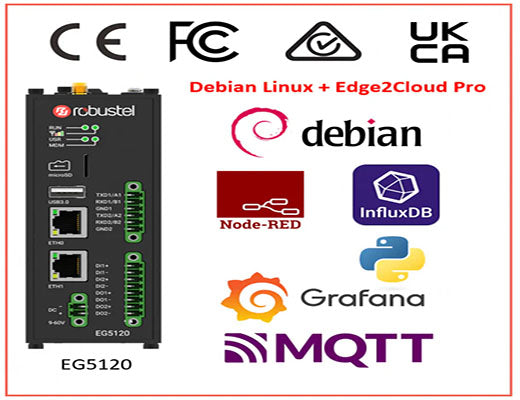
The Ultimate Guide to Building Your First Industrial IoT Solution with an Edge Gateway
|
|
Time to read 5 min
|
|
Time to read 5 min
Building your first Industrial IoT solution can seem like a daunting task, filled with complex choices about hardware, software, and cloud platforms. But what if you could go from unboxing to visualizing real-time data in minutes?
This guide is designed for IIoT beginners, project managers, and engineers looking for a simplified, all-in-one solution. We will walk you through the entire process of setting up a complete project using the Robustel IIoT Starter Kit as our primary example.
From connecting a sensor and gateway to processing data at the edge and creating a cloud dashboard, you'll learn how an integrated approach demystifies the path from sensor to cloud.
I've spoken with countless engineers who are excited to start their first Industrial IoT project. They have a clear goal—maybe it's monitoring machine health or tracking environmental conditions—but they get bogged down in the details. Which gateway do I choose? How do I connect this Modbus sensor? What's the best way to get data to the cloud securely?
The process of sourcing individual components, ensuring they're compatible, and then writing the software to make them all talk to each other is where many projects stall. It's a frustrating integration challenge. This is why an all-in-one IIoT starter kit is a game-changer. It's not just a box of hardware; it's a complete, pre-configured ecosystem designed to solve these problems for you. This guide will show you just how easy it can be to build your first industrial IoT solution.

The Robustel IIoT Starter Kit provides the two essential hardware components needed to create a powerful data collection and monitoring system.
The first step is the physical connection. Let's be clear: in the industrial world, you don't use flimsy jumper wires. We use robust, standard protocols.
The S6000U sensor communicates using Modbus RTU, a workhorse protocol in industrial automation. The real 'aha!' moment for many is realizing how simple this can be. You simply connect the sensor to the EG5120's RS485 serial port. This single, reliable cable provides both power to the sensor and a path for data communication. That's it. The hardware part of your Modbus data collection system is done.
Before we process data, let's make sure our gateway is securely connected and manageable from anywhere. This is where the cloud platform comes in.
This industrial IoT solution uses the Robustel Cloud Manager Service (RCMS) VPN tunnel. This allows you to remotely access your gateway's web interface and command line as if you were plugged directly into it, without ever exposing your device to the public internet. This is a critical security step for any professional deployment.

Now for the exciting part. We'll use the EG5120's edge computing power to run a popular open-source IoT software stack, often called the MING stack. The starter kit comes with pre-configured workflows to make this incredibly easy.
By processing data on the edge, this industrial IoT solution ensures real-time performance and reduces the amount of unnecessary data sent to the cloud.
For a deep dive into this software, read our guide: A Look at the EG5120's IoT Software Stack: Node-RED, Grafana, & More
The final step is to create a professional dashboard to visualize your data.
Using Grafana, which is running directly on your EG5120, you can connect to the local InfluxDB database as a data source. The IIoT Starter Kit comes with a pre-built Grafana dashboard template. With a few clicks, you can import this template and instantly see a real-time visualization of your S6000U's sensor data, including:
You've now successfully built a complete sensor to cloud data pipeline, from physical installation to a professional, web-accessible dashboard.

Building your first Industrial IoT solution doesn't have to be a complex, six-month integration project. By using an all-in-one IIoT starter kit, you can bypass the common hurdles of hardware compatibility and software setup. The combination of a powerful IoT edge gateway like the EG5120 and a versatile sensor like the S6000U provides a complete, production-ready platform. This approach not only accelerates your proof-of-concept development but also provides a reliable and scalable foundation that is ready to grow with your project.
A1: No. One of the biggest advantages is the use of Node-RED, a low-code programming tool. You can create complex data processing logic using a simple drag-and-drop interface, making this industrial IoT solution accessible to a wide range of skill levels.
A2: Yes. Remote access is handled through the secure RCMS VPN, and because the data processing happens locally on the IoT edge gateway, your sensitive operational data doesn't have to be sent to a public cloud for analysis, giving you full control and enhancing security.
A3: Absolutely. The EG5120 is a fully-featured industrial IoT edge gateway. You can connect additional Modbus devices to its serial ports, IP-based devices to its Ethernet ports, or even integrate other wireless sensors, making the starter kit a foundation you can easily build upon.


